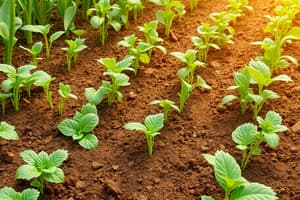Podcast
Questions and Answers
What is one primary goal of Precision Agriculture?
What is one primary goal of Precision Agriculture?
- Maintain environmental quality (correct)
- Increase waste
- Reduce profit
- Simplify data collection
Precision Agriculture involves averaging data across an entire field.
Precision Agriculture involves averaging data across an entire field.
False (B)
What other term is used to refer to Precision Agriculture?
What other term is used to refer to Precision Agriculture?
Site-specific crop management
Precision Agriculture is driven by ____________ variability.
Precision Agriculture is driven by ____________ variability.
Match the following benefits of Precision Agriculture with their descriptions:
Match the following benefits of Precision Agriculture with their descriptions:
What is a key benefit of Precision Agriculture?
What is a key benefit of Precision Agriculture?
Spatial variability is a crucial aspect of Precision Agriculture.
Spatial variability is a crucial aspect of Precision Agriculture.
List one technology used in Precision Agriculture.
List one technology used in Precision Agriculture.
Precision Agriculture allows for more precise decision making in __________ areas than the entire field.
Precision Agriculture allows for more precise decision making in __________ areas than the entire field.
Match the following terms related to Precision Agriculture with their descriptions:
Match the following terms related to Precision Agriculture with their descriptions:
Which of the following is NOT an area of interest in Precision Agriculture?
Which of the following is NOT an area of interest in Precision Agriculture?
Precision agriculture aims to apply inputs uniformly across a field.
Precision agriculture aims to apply inputs uniformly across a field.
What technology allows for real-time, continuous position information in precision agriculture?
What technology allows for real-time, continuous position information in precision agriculture?
Precision agriculture is driven by the need to reduce __________ degradation.
Precision agriculture is driven by the need to reduce __________ degradation.
Match the following tools with their primary functions in Precision Agriculture:
Match the following tools with their primary functions in Precision Agriculture:
Flashcards are hidden until you start studying
Study Notes
Precision Agriculture Overview
- Precision agriculture involves managing variations within a field to optimize farming practices and improve decision-making.
- Terms associated with precision agriculture include satellite farming and site-specific crop management (SSCM).
- It aims to reduce waste, increase profitability, and maintain environmental quality by focusing on spatial and temporal variability in crops.
Technology in Precision Agriculture
- Precision agriculture utilizes advanced technologies for data collection, processing, and analysis.
- Key tools include:
- Global Positioning System (GPS): Provides real-time positional data for mapping soil and crop conditions.
- Geographic Information Systems (GIS): Processes geographically distributed data for automated operations on farms.
- Remote Sensors: Use aerial or satellite imagery to detect field variations and assess plant health via vegetative indices.
- Variable Rate Technology (VRT): Applies inputs like fertilizers and pesticides based on specific needs identified through variability mapping.
Benefits of Precision Agriculture
- Facilitates efficient resource usage, ultimately lowering input costs and labor needs.
- Enhances environmental sustainability by optimizing input application based on field conditions.
- Generates farm-specific data, helping increase profitability and reduce environmental impact.
Implementation Steps in Precision Agriculture
- Identification and Assessment of Variability: Involves grid soil sampling and crop scouting to create variability maps.
- Management of Variability: Utilizes variable rate application and yield monitoring to implement site-specific strategies.
- Evaluation of Practices: Focuses on economic analysis, environmental assessment, and technology transfer rates to gauge effectiveness.
Critical Considerations
- Farmers must assess characteristics variation in soil and crops and its impact on yield and quality before adopting precision agriculture.
- Access to appropriate technologies and information is vital for profitable management of field variability.
Precision Agriculture Overview
- Precision agriculture involves managing variations within a field to optimize farming practices and improve decision-making.
- Terms associated with precision agriculture include satellite farming and site-specific crop management (SSCM).
- It aims to reduce waste, increase profitability, and maintain environmental quality by focusing on spatial and temporal variability in crops.
Technology in Precision Agriculture
- Precision agriculture utilizes advanced technologies for data collection, processing, and analysis.
- Key tools include:
- Global Positioning System (GPS): Provides real-time positional data for mapping soil and crop conditions.
- Geographic Information Systems (GIS): Processes geographically distributed data for automated operations on farms.
- Remote Sensors: Use aerial or satellite imagery to detect field variations and assess plant health via vegetative indices.
- Variable Rate Technology (VRT): Applies inputs like fertilizers and pesticides based on specific needs identified through variability mapping.
Benefits of Precision Agriculture
- Facilitates efficient resource usage, ultimately lowering input costs and labor needs.
- Enhances environmental sustainability by optimizing input application based on field conditions.
- Generates farm-specific data, helping increase profitability and reduce environmental impact.
Implementation Steps in Precision Agriculture
- Identification and Assessment of Variability: Involves grid soil sampling and crop scouting to create variability maps.
- Management of Variability: Utilizes variable rate application and yield monitoring to implement site-specific strategies.
- Evaluation of Practices: Focuses on economic analysis, environmental assessment, and technology transfer rates to gauge effectiveness.
Critical Considerations
- Farmers must assess characteristics variation in soil and crops and its impact on yield and quality before adopting precision agriculture.
- Access to appropriate technologies and information is vital for profitable management of field variability.
Studying That Suits You
Use AI to generate personalized quizzes and flashcards to suit your learning preferences.




